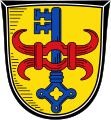Wall hooks (heraldry)

The wall hook is a common figure in heraldry . It is a simple coat of arms in the form of a wall anchor , but can be found quite often. The hook, which is also its older name, made of wrought iron or steel, serves as a protection built into walls to prevent high and long walls from breaking out. It is also used to anchor beams to each other or to the wall. In reality, you can often only see a flat iron, which is bent in opposite directions at the ends or only spread open on both sides. Simple hooks are also known.
In heraldry, the terms “double hooks”, “wall hooks” or “house anchors” are used to clarify their use and appearance. It is also called "barb". Its diversity is insignificant. The heraldic representation is limited to a single part and two elements of this fitting piece placed in a slanting manner . Hovering in the shield, it lies horizontally or obliquely to the left or obliquely to the right. The coloring or tinging differs from the substrate. Two or more next to and one below the other are possible.
Wolfsangel
It is often confused with the wolf tang , the upper part of which, the wolf anchor, looks like a chopping knife with an eyelet down. However, the frequent use of the wolf fishing rod does not indicate strong wolf hunting in the corresponding regions. The wolf weapon is therefore excluded as a special sign of validity for the coats of arms of the nobility and the community. Many representations and blazons of double hooks are not always correct or inconclusive with many coats of arms. They may change their meaning in the course of the history of the respective coat of arms, so that the double hook is sometimes described as a component (wall hook), and sometimes as a hunting device (wolf iron). The current state of research in heraldry can only clearly clarify the origin of the double hook in a few cases.
If a double hook is described as the lower, actual component of the wolf tang, this hook should have a hole in which the chain or rope is connected to the "chopping knife", although this double hook is also connected to a rope without the "chopping knife" on the second hook were posted. In coats of arms, these double hooks without a hole are also described as landmarks. Landmarks (meaning as shame stone or weight is not applicable here) are boundary or land stones on which symbols of the owner are attached. These land stones, also known as patch stones, also bear the symbols of a town. In heraldry, the term district mark is also used. Derived from the word district , the area of a municipality. This is where these double hooks become house brands . The similarity with wall hooks is more obvious, as wall hooks or wall anchors often carry this house brand. Coats of arms from Ditzingen , Neckartailfingen and Pleidelsheim are examples.
- Examples
Wall anchor in Bad Dürkheim , derived from the local noble family
Wolf hook - lower part of the wolf tang
Coat of arms of those von Hake with three simple wall hooks








